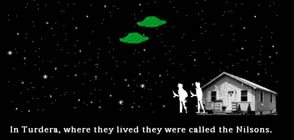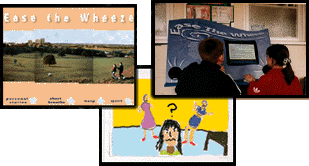
Keywords:
activism
hacktivism
tactical media
net.art
community art
class
funding
politics
museum education
audience development
US/UK comparisons
People:
Kim Abeles
Appalshop
La Compagnie
Electronic Disturbance Theater
Gran Fury
Roz Hall
Ikon
Jubilee Arts
Los Angeles Poverty Department
Matthew Fuller
New Art Gallery, Wallsall
Steve Kurtz
Mervin Jarman
plugin
rtmark
Toy Wars
Whitney Biennial
New media, 'community art', and net.art activism. Interviews with Natalie Bookchin and Brendan Jackson.
Natalie Bookchin is active in net.art and activism, and is based at CalArts, California. She is currently participating in a residency at MECAD, Barcelona. She was interviewed by email, by Beryl Graham, January 2001.
(This web page features edited excerpts from the interviews. To download a longer 6000-word pdf text file, click here).
Beryl Graham: You've had experience of 'hacktivism', and net.art. Would you differentiate them, and if so, how?
Natalie Bookchin: … at times the two practices overlap, but other times they don't. Early net art tended to have an activist bent to it, in part because it emerged in the context of an on-line scene active in the free distribution of information, software and ideas in the face of the imminent commercializing and 'malling' of the net … On the other hand there are hacktivists and net activists who do not see themselves as artists per se, but I would argue that their practices can often be seen as a form of art, in their creative and subversive uses of form and content, and their symbolic, representational and practical work which rubs itself against the commercial and corporate grain.
On and off line activism are not mutually exclusive. In fact, net activism often works quite effectively in conjunction with simultaneous off line practices. This is the case for some of the most effective projects of the on-line activist group rtmark, the collective actions known as Toy Wars, and the activities of Electronic Disturbance Theater.
Gatt.orgwas launched during the few weeks before the World Trade Organization was to meet in Seattle in the Fall of 1999 … Soon after the site was published the Director General of the WTO distributed a press release harshly criticizing gatt.orgfor being "deceptive", thus assisting rtmark in bringing even more public and media attention to our site. While a series of exchanges between rtmark and the WTO were taking place, thousands of activists were protesting in the streets in Seattle. The on-line activities did not replace the off-line ones, but instead each reinforced the other … The rtmark site was produced by 4 people with limited resources, yet … it can reach on-line audiences as well as the media that love to cover these technologically 'sexy' actions.
BG: You've had experience both in the USA and Europe. Would you say there are national differences in approach?
NB: … In my experience as part of the American-based collaborative group, rtmark, I found that the work initially received more attention from European audiences than those in the USA, even though one might argue that the group has a particularly American approach. One of the tactics rtmark has developed is tailoring the work to the mainstream media, by using humor, satire and wit when addressing serious political issues. This works well in the USA, where news is often reduced to a catchy sound bite and well placed image, but the popularity of rtmark internationally (including the international media) means that this sensibility is not unique to the States, and that local political differences are to some degree transgressable …
BG: At the Terminal Futuresconference (ICA, London, Oct 1994) Steve Kurtz of the Critical Art Ensemble argued that because multinational companies oppressed people nomadically (choosing the least empowered countries), then resistance should be Net-based rather than community-based. Matt Fuller suggested that this might be an example of a privileged "White Flight into cyberspace" away from the physical problems of actual communities …
NB: I would agree with Matt Fuller that the CAE position from 1994 can be seen as a cynical and privileged position. I wish that CAE would write a follow up to their polemic essay of that same year, "Electronic Civil Disobedience" where they argued that the streets are dead, and "Electronic Civil Disobedience" in the form of "electronic disturbance" (blocking the flow of information in cyberspace) should replace traditional civil disobedience in the streets.
Institutional power may indeed be located in electronic data streams, but the streets are not in any sense dead, and very effective political grass roots practices still can emerge at a local level [see La Fiambrera's actions in Seville]. However, I would argue that work produced on the net can also carry powerful socially charged meaning with real effect. Fuller has certainly shown this, for example with his group IOD's production of an alternative browser The Web Stalker that has been freely distributed to thousands of people on-line …
… It is not an either/or situation. I also believe, as I argue in my project Street Action on the Superhighway that the Internet can function like a street, as a way to build networks and connections and lead to real action, just as the street can also function as network …
BG: The problems of subaltern access to new technologies have been well discussed. Have you come across any particularly good solutions/approaches to this (including lo-tech solutions)?
NB: I don't find new technologies any more or less elitist than other communication forms of the last century … the real challenge is to turn these activities into politicized and socially charged activities …
There are vast audiences of bored surfers on the net. My interest lies in trying to get them off their normal tracks, and onto others … The Intruder … looked like a game but in fact was a critical commentary on computer games and patriarchy.

Last week I was in Marseilles where I had been invited to give a series of workshops and lectures based around this project. The art space that invited me, La Compagnie, is located in a poor Arab neighborhood. I gave a series of workshops to local neighborhood kids in which I had them remake my game, replacing my images and texts with their own. They responded immediately because not only were they attracted to the possibility of playing a game, but they realized that they could intervene in the process - that is become producers rather than simply consumers of a popular culture. This was just a short 2-day workshop where they learned how easy it was to actually make something they previously assumed was only consumable. Mervin Jarman, based in Jamaica and London, has been working on this type of distributed production with his Container Project, where he takes new technologies on to the streets and keeps them there for a sustained period of time.
In my current project in development [at manalife.com from Sep 2001] I am making a real functioning on-line virtual pet game, where the virtual pet in this case is a human worker. This game will seek to attract not simply an audience looking for art, but on-line game players looking for games. In order to get points needed to keep ones pet alive, players will need to leave the game and perform other on and off line activities that have potential political effect.
BG: Mainstream art galleries and museums sometimes engage with activist or hacktivist art - have you experienced any particularly good (or bad) examples?
NB: The Whitney Biennial decided to expand their exhibition and show net art in 2000. Unfortunately they presented half a dozen or so projects on one single computer, on a pew-like bench and with a screen projection of the work. It was not clear why one needed to sit in an uncomfortable museum setting, and look at projected work on a screen. … What is the motivation to pay an admission fee and see the work in the less comfortable space of a museum?
On the other hand there is a new space being developed by Annette Schlinder in Basel called plugin where she is creating a comfortable media lounge like environment that encourages people to stick around for more than the normal brief time it takes to consume art objects, and to mingle with others on and off line.
BG: What three bits of advice would you give to arts workers and curators engaging with new media activist or community art?
NB: More than three bits of advice can be found by simply doing research and checking out what has already been done on the net, following debates and examining past tactics. … see http://www.calarts.edu/~line/history.html OR http://www.calarts.edu/~line/words.html

Brendan Jackson works at Jubilee Arts, a community arts organisation in the West Midlands, UK. He is currently making a graphic novel called Bedtime Stories with a homeless/settlement project and comic artist John McCrae. He was interviewed by telephone, by Beryl Graham, January 2001.
Beryl Graham: Do you think that there are any particular features of new media, which really make a difference to the way you work or what you're able to do?
Brendan Jackson: … it makes you work faster, and the work is more impressive and 'flash'. New media does open up more opportunities for us because the end product can be more public - its an opportunity to share it more - it can be more visible …
I think that in terms of the web then it has this incredible potential for distribution … but how do you publicise it and how does anyone get to know about it? The community arts movement has probably been pretty bad at actually documenting the work, and consequently you are always finding people who are reinventing the wheel.
I think that the emergence of all these networks and different communication technologies means that the kind of community based work that we do, doesn't need to be confined to a specific place or location … Sandwell is an interesting case because it has no real town centre, it grew up as a set of six small manufacturing villages … You're from Cradley and you're a foreigner in Wednesbury. So it's an interesting place to be using the Internet, because people are more likely to relate to someone from Helsinki than they are to somebody three miles down the road.
Also, in the process of project work, access to the web has been very useful for us on a number of levels. We did a project about asthma called Ease the Wheeze which started as a CD-ROM and ended up as a strangely shaped information kiosk. It featured a little journey with landmarks like the local factory, but … the most useful factual information came from the web rather than what we got out of any local doctors or the health authority. The important thing though, is what you do with the information once you have got it, especially in terms of the context, site, situation and your local community.

Certainly digital media mean you can actually push people's aspirations in terms of quality because so often people think "Well, community art, it's a bit naff isn't it really - terribly worthy but you get a crappy sub-standard product." Whereas most people want things to be as good as anything they see out there in the market place. I think you can get that with using digital media but also there is a danger of it being shallow and superficial and glossy. People's expectations are much higher. I think digital media might be more interesting possibly than the old kind of photo workshops or silkscreen workshops, in that digital media is much more in the high streets, much more in your face. It has been shipped into your homes, workplaces and schools at a tremendous rate - it was quite interesting to see the Sony Go Create campaign which is all about people making their own little videos and life stories - it's been pitched at creating material for your own little niche market - your immediate friends and family.
BG: You've had experience both in the USA and Europe. Would you say there are national differences in approach?
BJ: One big difference is the curse and blessing of funding. In the UK … it allows for certain longevity of arts projects but I think that doesn't always encourage risk taking. People like the LAPD (Los Angeles Poverty Department), Gran Fury or Appalshop, they just did what they really wanted to do, not because there was a funding opportunity - that came later. … I've always had the impression in the States though, that it is very focused on The Artist. There are artists like Cherie Gaulke or Kim Abeles whose work does involve people in various ways, but they are more likely to get funding for a project based on their personal artistic reputation rather than its value as a community based project, which I think is an interesting difference.
BG: Many community darkrooms set up in the 70s/80s closed when funding fashions changed. Is there a danger of the same thing happening to new media workshops?
BJ: Yes, it probably will happen - it may be no bad thing … if your whole practice is just based around the fact that you have a digital media suite you will go out of fashion. Again, it's about content really.
The real paradox at the moment is that a lot of communication is now mediated by technology and is something quite hidden. Most people, like me, don't fully understand these technologies, so access to them and to be able to do something with them rather than just consume them is important - half the people in Sandwell don't own a car let alone a computer. We did a three-year project with Roz Hall and the University of Central England, which looked at the production and consumption of digital imagery by young people. Working class youth around here are consumer fodder - they go out and buy the Playstation games but do not necessarily make stuff or have opportunities to get involved in the making of it, so a lot of our work is around that issue.
BG: Mainstream art galleries and museums sometimes engage with 'community' art - have you experienced any particularly good (or bad) examples?
BJ: The cynic's view is that a lot of mainstream art galleries will engage with the community because they want to access funding - because it's their criteria or their accountability. In our experience it certainly can be an uneasy dynamic between a curator, an education officer or a 'new audiences development officer' (pick a job title). There is a certain pecking order or prestige attached … Years ago our exhibition called Bickle, made with Afro-Caribbean elders, … got quoted in libraries and museums reports as a model project … but it never appeared in the hallowed art galleries.
The New Art Gallery in Walsall has built up some quite good relationships with other groups in the borough like Walsall Youth Arts or the Wallsall Community Arts Team and it certainly seems there is a kind of willingness to realise that a partnership is a two-way street. It's not a 'top down' bringing the goods down from the high table to the people at the low table, it's a recognition that you will all bring skills and ideas and experience to the table.
We did a project with the Ikon … called Art on your Doorstep … The Ikon curators, education staff etc. did sit down and evaluate it and (no surprise to a community artist) you can engage people, they are interested and you can do some positive and interesting work …
BG: What three bits of advice would you give to arts workers and curators engaging with new media community art?
BJ:
1. Be prepared to take risks, do something challenging rather than always repeating something tried and tested. I think funders need to recognise that sometimes they need to be prepared to fund risks.
2. Network and share - there is usually someone else out there doing what you do or want to do - find them. They may not necessarily be other artists.
3. Be persistent. If you stick around long enough, you'll get subsumed into the structure, but that doesn't mean you need to be institutionalised and neutralised. Yes, it's important to run an organisation in a fair and equitable way, but if you spend more time working with consultants on a Human Resources Plan than with people out there, on the street, and if you spend more time talking about the art rather than actually doing the art, then you're going nowhere fast.
^ top